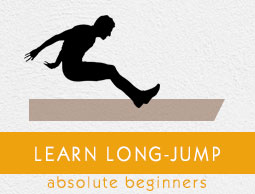
Long Jump - Training
Instead of learning much difficult techniques, one should focus on the basics to master this sport. Two things that matter the most in this sport are speed and lift at the takeoff point. Flight techniques and landing are equally important. An athlete needs to attain a good speed within a given specific distance boundary.
During the preliminary training, one should not be introduced to the take-off board directly. The following points should be kept in mind during the initial stages of training −
Your head should be upright throughout the jumping session.
Choose a jumping area that is more suitable to have sideways jumping.
Initially, you should make short approach run and should mark the places where the running actually starts.
Apart from these, it is also advised to the starters not to take long run initially. Take short approach, run, take-off, and land naturally at whatever position you are comfortable with your speed. If you take-off through a long run without practice, then fatigue can occur quickly and this will affect further practice.
Make sure that you run fast during your practice session with your head upright.
Make a flat back land off with your legs being stretched straight.
Take-off leg should be extended as much as possible to cover a good distance.
Do not keep your arms tight. Instead, keep them free and swing them with body movement to get maximum momentum.
Some points should be noted about take-off foot. Only sailing is done with proper tactics.
Make sure that the heel of your feet will lands first.
As the take-off proceeds, there will be a rolling action of the ball of the foot.
Make the use of the toes of your take-off foot and rise it up against air as high as possible.
Running should be done in fast-foot action manner. That means, pawing should be done first, then extension of the take-off leg should be made with much speed. During the take-off process, the mid-line of the body should contain the foot. The pointing direction of the foot should be in the forward direction of jump.
Dos and Donts during the Practice
The following points should be in your checklist during practise −
Till the take-off point, do maintain your speed at any cost.
As soon as you cross the board, give a rapid boost to your speed.
To maintain more upright positions, do experiment on your running styles that suit you better.
Compensatory action of the arms should be done to give the momentum.
Landing drills should be added to the practice schedule.
The following are the things that you should not do −
Just before take-off, shortening or lengthening the stride.
Without attaining much speed, taking-off from the hill.
Inclining the trunk too far forward or backward.
Imbalance during the flight.
Positioning one foot below the other foot during the landing phase.